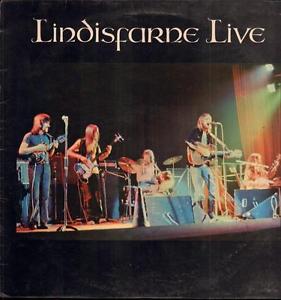 The first hint that Lindisfarne Live is going to be a disaster comes literally twenty-two seconds in on the disc, when lead singer Alan Hull shouts the magical words “Rock and roll!” to the audience. A simple rule of thumb for live albums is this: If the band has to remind you it’s rock and roll, then it probably ain’t. Sadly, Lindisfarne Live hews to this truism through most of its length.
The first hint that Lindisfarne Live is going to be a disaster comes literally twenty-two seconds in on the disc, when lead singer Alan Hull shouts the magical words “Rock and roll!” to the audience. A simple rule of thumb for live albums is this: If the band has to remind you it’s rock and roll, then it probably ain’t. Sadly, Lindisfarne Live hews to this truism through most of its length.
Musically, Lindisfarne comes across as a lighter, poppier version of Runrig. It’s the folk music equivalent of Southern rock, and if Runrig is Scotland’s Lynyrd Skynyrd or Allman Brothers Band, then Lindisfarne is trad-rock’s .38 Special.
Regardless, the vast majority of the repertoire displayed on Live falls within a fairly narrow set of boundaries. It’s relentlessly upbeat, reasonably fast, and disturbingly peppy. Even the stuff that’s supposed to be a change of pace wanders into the same old 120-beats-per-measure-with-close-harmony-singing territory, which makes it hard for the casual listener to figure out exactly which track he’s listening to at any given moment. Throw in the fact that a few tracks (“Fog on the Tyne” and “Roll On That Day,” in particular) stretch on for 6 minutes-plus, and the end result is not so much seamless as shapeless. (In truth, that’s one of the biggest problems exhibited by Lindisfarne’s songwriting — the inability to end a song in a timely manner. The repetitions of the chorus at the end of a given song seem endless. While the foremost practitioner of this sort of musical sin is Don Henley, at times Lindisfarne seem inclined to give him a run for his money.)
Live‘s real sin, however, is that it fails to take advantage of the fact that it is indeed a live format. It’s clear that the band wants the listener to know that it’s live — in-between song raps with the audience are preserved in at least some of their glory, though their content is pretty much limited to rah-rah cheerleading. There are careful doses of rabid audience cheering mixed in carefully between tracks as well. But the performances are somehow lacking in energy. There’s little to distinguish the actual music from something recorded in a studio.
Not all of the album’s bad, which is what makes its overall flaws that much more disappointing. “Lady Eleanor” invokes Jethro Tull without mimicking it shamelessly, which enables the song to stand out. “Walk In The Sea” is at least a change of pace, and an interesting one. “Knacker’s Yard Blues” would be fun, were it not for the cringe-worthy shout of (you guessed it) “Rock and roll!” during the intro. For all its length, “Fog on the Tyne” does have more energy to it than the norm. On the other hand, the misbegotten “I Want You To Be My Baby” does much to take back any goodwill the album’s better tracks generate.
In the end, Lindisfarne Live is likely to please existing fans of the group and do absolutely nothing to win new ones. It falls prey to all of the pitfalls that can snare a live album — lengthy, cutesy band introductions; merely workmanlike musicianship; hackneyed conversation with the audience — and transcends none of them. This album could have been a marvelous introduction to the band, but in the end it’s for Lindisfarne completists only.
(Code 90 Records, 1993)
